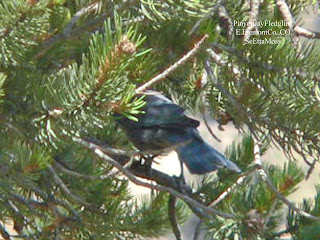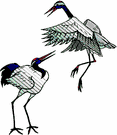 Photo by Dave Menke--Courtesy of U. S. Fish and Wildlife Service
Photo by Dave Menke--Courtesy of U. S. Fish and Wildlife ServiceWhile doing surveys for one of my BBA-II routes today, I found a Pinyon Jay creche (basically a baby nursery where the fledglings gather together to wait while parent birds are out foraging). I spotted the first flegling, with it's reddish mouth lining and yellow corners), in a pinyon pine tree. Though fledglings are capable of, and are supposed to, remain quiet (so as not to attract predators) this young bird was calling loudly to be fed.
As I read in "Birds of North America online" (BNA), there are several adult birds that sit quiet in nearby vegetation and guard over the creche. After I spotted this fledgling, I could hear some vocalization from the inside of other pinyons and junipers in the area, presumably adult birds warning the fledglings that some bipedal critter was in the area and might eat them. Other than the begging fledgling, all the other communication I heard was quite soft in volumn as the jays in the nearby trees communicated with each other.
I would never have guessed there were 10 or so jays, some adults and others fledglings, in nearby trees all around me as they had been sitting quietly when I arrived. They were quiet stealthy, making quiet calls from the inner branches of trees then when I was looking another way one would fly past allowing me only a glimpse. Of course, I was also trying to be stealthy, moving as quietly as I could (likely sounded like a herd of horses to the jays) as I also moved from tree to tree also trying to use the branches to obscure my profile. Clearly my efforts were unsuccessful as the adult jays moved the fledglings to more distant trees away from my prying eyes.
I had thought I heard Pinyon Jays in this same location a few weeks ago but all I heard were a few short and quiet calls. Though Pinyon Jays can be exceptionally loud with alarm calls that can be heard more than a mile away per BNA, they can be very quiet especially when nesting. The area they are in is pinyon-juniper habitat, which was where the overwhelming majority were found during the BBA-I surveying, but these were only a few hundred yards from a outlying residential area where someone likely feeds them.
SeEtta
Labels: creche, Pinyon Jays
 Boy, this seems to be a great time for seeing dragonflies, at least for me. I found this neat dragonfly on a shrub in my backyard in Canon City this morning. I feel pretty sure (given that I am a novice) that I have it's identification correct--a female Western Meadowhawk (it's even got a cool name). It's latin name is Sympetrum semicinctum fasciatum (uh, I like Meadowhawk better and I found a different latin name for this species). Fortunately these pics are almost as good as the photos I took.
Boy, this seems to be a great time for seeing dragonflies, at least for me. I found this neat dragonfly on a shrub in my backyard in Canon City this morning. I feel pretty sure (given that I am a novice) that I have it's identification correct--a female Western Meadowhawk (it's even got a cool name). It's latin name is Sympetrum semicinctum fasciatum (uh, I like Meadowhawk better and I found a different latin name for this species). Fortunately these pics are almost as good as the photos I took. Strangely (given all the resources on the internet) I couldn't find much about this species. I did find that males have reddish bodies (I don't know their parts well enough to be more specific) while the females like this one are yellowish.
Strangely (given all the resources on the internet) I couldn't find much about this species. I did find that males have reddish bodies (I don't know their parts well enough to be more specific) while the females like this one are yellowish.













































